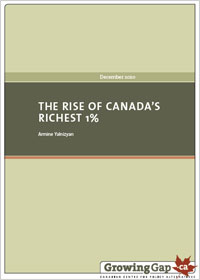This is an archive of news stories and research from the National Union of Public and General Employees. Please see our new site - https://nupge.ca - for the most current information.
The Gilded Age of the 1920s is back for the super-rich while the middle class treads water or struggles to keep from sliding backward.
 Ottawa (2 Dec. 2010) - Canada has returned to a 1920s-style Gilded Age where the super-rich consolidate their wealth while the middle class stagnates and struggles to keep from sliding backward.
Ottawa (2 Dec. 2010) - Canada has returned to a 1920s-style Gilded Age where the super-rich consolidate their wealth while the middle class stagnates and struggles to keep from sliding backward.
That's the conclusion of a new study by the Canadian Centre for Policy Alternatives (CCPA) called The Rise of Canada's Richest 1%.
It is based on income-tax forms filed up until 2007, showing that the richest 1% took home 13.8% of all incomes recorded that year.
The share of total income going to the richest of the rich has risen steadily since the 1980s, when former American President Ronald Reagan ushered in a false era of "trickle down" economics in which the lavishing of even greater wealth on the wealthy was supposed to filter down to the rest of society.
The related policies that have so damaged the American middle class have now been widely mimicked in Canada, Britain and much of the industrialized world - the result being that the rich have laughed all the way to the bank while the rest of society has stagnated or slipped behind.
What has happened has reversed a long-term trend toward a more equal distribution of Canada's income during the post war '50s, '60s and '70s, the CCPA study says.
"The higher up the ladder you go, the more colossal this glomming of wealth becomes," says author Armine Yalnizyan, a senior CCPA economist.
Her analysis is based on tax form data collected by Mike Veall, an economics professor at McMaster University in Hamilton.
The numbers show that the richest 1% quickly gained ground in Canada between 1925 and 1935.
"Like the Gilded Age a century ago, Canada is awash in money generated by an emerging new global economy," Yalnizyan writes.
"During both slow and rapid periods of growth, incomes have increasingly become concentrated in the hands of the elite few rather than creating greater prosperity for all."
The inequality gap of the '20s and early '30s eventually collapsed and then switched direction with the Second World War, narrowing and steadily declining until about 1982. Since then, the super-rich have gradually claimed larger and larger pieces of the total income pie.
"Most Canadians are inching their way through recovery, trying to hang on to what they've got," Yalnizyan writes. "But for some Canadians things have never been so good."
The higher up the income scale, the more dramatic the gains. For the richest 1%, the share of all Canadian incomes almost doubled between the late 1970s and 2007. For the richest 0.1% of tax files, their total share almost tripled during those 20 years.
For the creme-de-la-creme – the richest 0.01% making more than $640,000 a year - their share of total incomes more than quintupled.
NUPGE
The National Union of Public and General Employees (NUPGE) is one of Canada's largest labour organizations with over 340,000 members. Our mission is to improve the lives of working families and to build a stronger Canada by ensuring our common wealth is used for the common good. NUPGE
More information:
Download CCPA study: The Rise of Canada's Richest 1%
